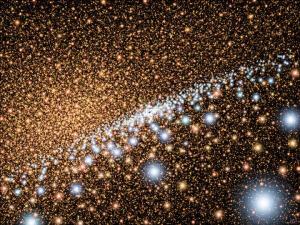
© NASA, ESA, and A. Schaller (for STScI)This artist's concept shows young, blue stars encircling a supermassive black hole at the core of a spiral galaxy like the Milky Way. The background stars are the typical older, redder population of stars that inhabit the cores of most galaxies (including our own). CfA astronomers caught two stars in the act of forming within a few light-years of the Milky Way's center. Their find demonstrates that stars can form at our galaxy's core despite the powerful gravitational tides generated by the black hole.
The center of the Milky Way presents astronomers with a paradox: it holds young stars, but no one is sure how those stars got there. The galactic center is wracked with powerful gravitational tides stirred by a 4 million solar-mass black hole. Those tides should rip apart molecular clouds that act as stellar nurseries, preventing stars from forming in place. Yet the alternative - stars falling inward after forming elsewhere - should be a rare occurrence.
Using the Very Large Array of radio telescopes, astronomers from the Harvard-Smithsonian Center for Astrophysics and the Max Planck Institute for Radio Astronomy have identified two protostars located only a few light-years from the galactic center. Their discovery shows that stars can, in fact, form very close to the Milky Way's central black hole.
"We literally caught these stars in the act of forming," said Smithsonian astronomer Elizabeth Humphreys. She presented the finding today at a meeting of the American Astronomical Society in Long Beach, Calif.









